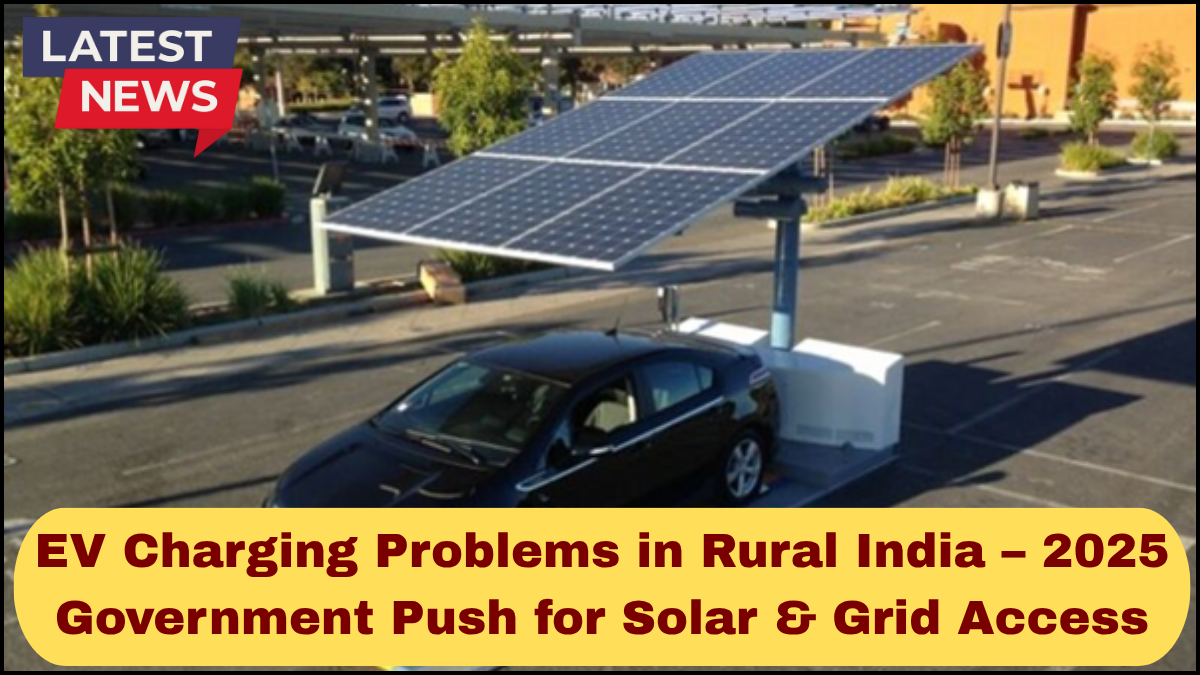India’s electric vehicle (EV) revolution is gaining momentum, but rural regions still face significant obstacles in adapting to this transition. While urban areas are steadily upgrading their infrastructure, Rural EV Charging Challenges remain a major roadblock. In 2025, the Indian government has initiated a robust push to improve electricity supply & solar push in these underserved areas. This article breaks down the root of the challenges and how policy-level interventions are attempting to bridge the gap.

Limited EV Charging Infrastructure
In rural India, the biggest hurdle to EV adoption is the absence of a reliable and accessible charging network. Unlike cities that enjoy a growing web of fast-charging stations, many villages don’t have even a single public EV charger.
The problem is compounded by logistical challenges—poor road connectivity, dispersed populations, and lack of real estate for installing charging hubs. Charging infrastructure companies often shy away due to low initial returns and uncertainty about usage patterns in remote locations.
Unstable Electricity Supply
Electricity supply in rural areas is still far from consistent. Power outages, voltage fluctuations, and limited load capacity make it nearly impossible to rely on grid-based EV charging alone. Even in 2025, many villages in states like Bihar, Jharkhand, and parts of Uttar Pradesh face daily power cuts, often lasting several hours.
For EV users, this means unreliable charging schedules and increased range anxiety. Fleet operators, especially in logistics and rural transport, cite this as a primary reason for avoiding electric two- and three-wheelers in the hinterland.
The Government’s 2025 Solar Push
To address these gaps, the government has rolled out an aggressive solar push in rural areas. Through the PM-KUSUM and National Solar Mission initiatives, thousands of solar microgrids and decentralized solar charging stations are being deployed in partnership with state governments and private developers.
These solar-powered setups not only reduce dependency on erratic grid supply but also bring down the operational cost of charging. In states like Rajasthan and Madhya Pradesh, early-stage solar charging pilots have shown promising results—offering uninterrupted service even in areas with weak grid connectivity.
The Ministry of New and Renewable Energy (MNRE) has also introduced subsidies for setting up solar EV chargers in rural clusters, targeting agricultural communities and small-scale transport operators.
Grid Access Improvements & Modernization
In tandem with the solar strategy, the government is fast-tracking rural grid modernization projects. Under the Revamped Distribution Sector Scheme (RDSS), power utilities are upgrading transformers, laying high-capacity lines, and integrating smart meters.
This dual-pronged approach—solar plus grid enhancement—aims to make rural EV charging more sustainable and reliable. Additionally, there is a growing focus on hybrid systems that use both solar and grid power with battery storage, ensuring 24/7 uptime for chargers.
Private Sector Participation
Encouraged by government incentives, several startups and energy companies are stepping into the rural EV space. Companies like SunMobility and ChargeZone are piloting modular, swappable battery stations tailored for low-income, off-grid areas.
Additionally, some agri-tech platforms are integrating EV charging facilities into existing infrastructure such as fertilizer outlets and mandi warehouses—making them multi-utility rural hubs.
Need for Local Awareness and Training
Another barrier often overlooked is the lack of awareness and technical knowledge. Local communities remain hesitant due to myths about battery fires, maintenance costs, and service availability.
In response, the government and NGOs are conducting grassroots workshops to educate farmers, women’s self-help groups, and local mechanics about EV technology, safety, and business potential. This grassroots-level engagement is vital for building trust and long-term adoption.
Policy Outlook: What’s Ahead?
The Indian government has made rural electrification and clean mobility part of its long-term energy strategy. By 2030, it aims to make 30% of all new vehicle sales electric, with at least 25% of rural transport electrified through solar-grid hybrid models.
Ongoing partnerships with international agencies such as the World Bank and International Solar Alliance (ISA) are providing financial backing and technological expertise for scaling rural EV charging networks across the country.
FAQs
1. Why are rural EV charging challenges more severe than in cities?
Because rural areas suffer from inconsistent electricity supply, lack of infrastructure, and limited investment incentives, making it harder to support reliable EV charging networks.
2. How is the government addressing these problems in 2025?
The government is promoting solar-powered EV chargers and upgrading the rural electricity grid through targeted schemes like PM-KUSUM and RDSS.
3. Can solar power alone meet EV charging needs in rural areas?
Solar alone can handle low to moderate demand, especially for two- and three-wheelers. However, hybrid systems combining solar with grid power and battery storage offer more reliability.
4. Are there any incentives for setting up rural EV charging stations?
Yes, the government offers subsidies and tax benefits for solar EV charging stations in rural areas, especially for those targeting farmers and local transport operators.
5. What is the role of private players in solving rural EV issues?
Private companies are developing cost-effective, modular, and scalable solutions such as battery swapping and mobile charging units, often in partnership with local entrepreneurs.
clcik here to learn more